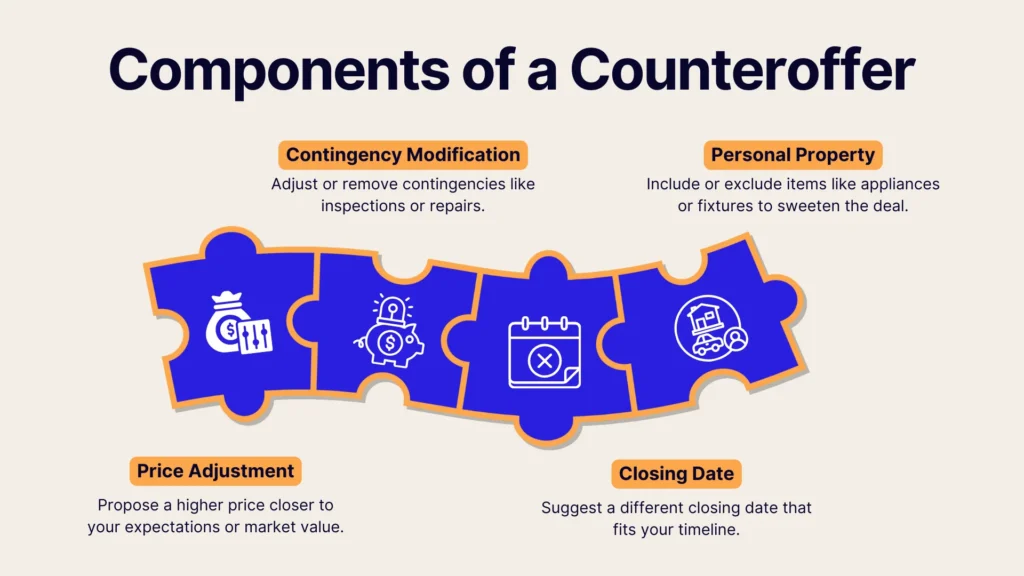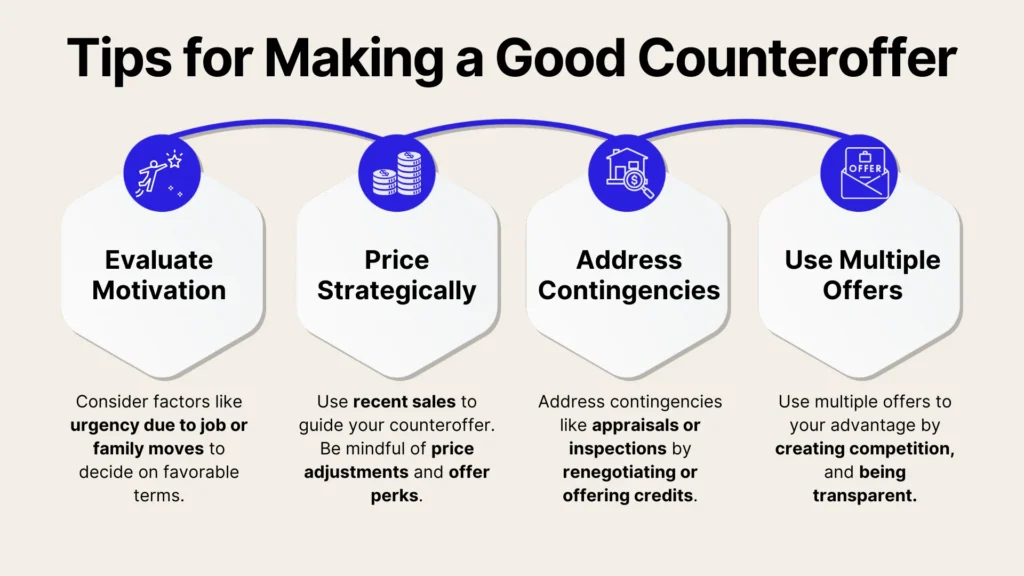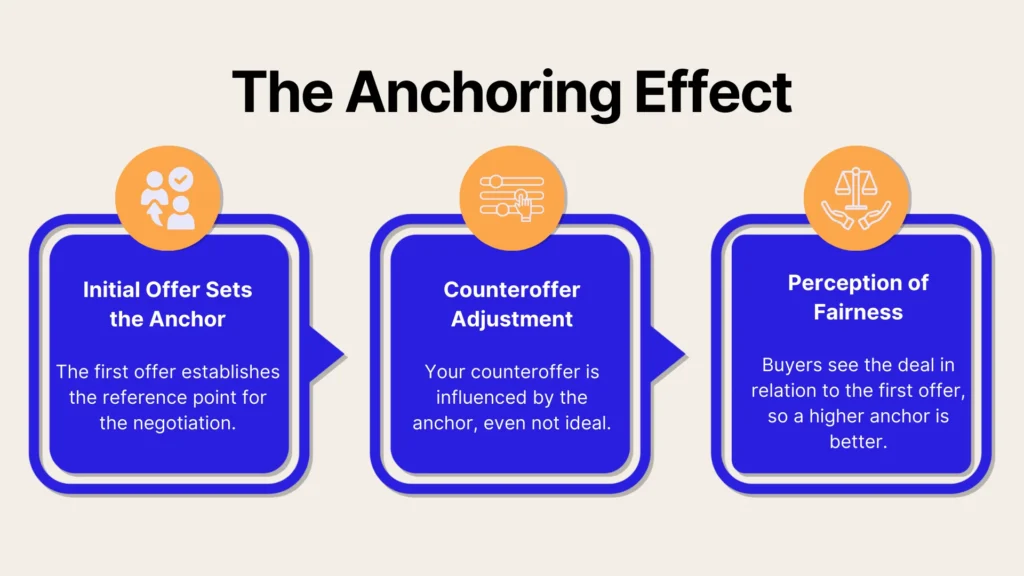Navigating the world of real estate can feel like walking a tightrope: there’s a delicate balance between what you want and what a prospective buyer is willing to accept. A core part of this balancing act is the counteroffer process, which can either seal a lucrative deal or derail promising negotiations.
While it may seem daunting, understanding the ins and outs of counteroffers can help you stay confident, protect your financial interests, and steer transactions toward mutually beneficial outcomes.
Let’s dive deeper into the basics of counteroffers, where you’ll explore why they’re made, what they include, and how they shape the entire negotiation process.
Understanding the Basics of Real Estate Counteroffers
A counteroffer is more than just a buyer’s or seller’s second request; it’s a pivotal tool that refines the terms of a property transaction. At its core, once an original proposal is submitted – whether it’s from the buyer or the seller – the receiving party can either accept, reject, or propose alterations. Those alterations become the counteroffer, resetting the negotiation stage.

Definition and Purpose of a Counteroffer
In real estate, a counteroffer helps buyers and sellers find common ground when the initial offer doesn't meet expectations. Be it price, timing, or property concerns, counteroffers keep negotiations open and progressing. About 60% of home sales involve counteroffers, highlighting their key role in reaching a final deal.
Key Elements of a Counteroffer: Price, Terms, Contingencies, and Timelines
Counteroffers revolve around a few main pillars:
- Price: This is the most common point of adjustment. If a seller believes the offered amount is too low, they might propose a slightly higher figure. Conversely, a buyer might request a price reduction after reviewing the home’s inspection report.
- Terms: These can include earnest money deposits, who pays for closing costs, or requirements for home warranties.
- Contingencies: Contingencies are conditions that must be met for the sale to proceed, like the home passing a satisfactory inspection or the buyer securing financing.
- Timelines: Whether you need to close quickly or prefer a more extended period to relocate, timelines can be negotiated through counteroffers.
Common Reasons Counteroffers Are Made
Counteroffers happen when the initial bid doesn’t quite match the seller’s goals or the buyer’s budget. Sellers might push back if the market’s hot, giving them leverage to ask for more. Buyers, on the other hand, might counter after an inspection or if they think the price is too high.
Knowing how counteroffers work is key, because the right strategy can mean the difference between a great deal and a missed chance.
Why Strategies Matter in Real Estate Counteroffers
When selling or buying property, it’s tempting to rely on gut feeling. However, real estate is often a high-stakes game, and winging it can lead to less-than-ideal results. Having clear strategies will give you a competitive edge. Let’s take a closer look at how planning ahead will impact your counteroffer success:
- The competitive nature of real estate markets: In hot housing markets, properties can attract multiple bids within hours. Strategic planning helps you stand out or respond confidently, preventing you from being overshadowed by more assertive buyers or sellers.
- Aligning counteroffers with negotiation goals: A successful counteroffer isn’t purely about raising or lowering the asking price; it’s about aligning contract terms with your broader objectives. Timing, financing, contingencies, and closing costs can all be used as strategic levers.
- The risk of poorly handled counteroffers: A careless or overly aggressive counter can scare off the other party. On the flip side, too many concessions might hurt your bottom line. Strategy is the guiding force that keeps negotiations on track and avoids deal-breakers.
Strategies for Sellers Making a Counteroffer

Once you recognize the value of a well-planned counteroffer, the next step is figuring out exactly how to put it all into action. Explore a set of powerful tactics, ranging from evaluating your initial offer to leveraging buyer competition that can help you secure the best deal possible.
Evaluating the Initial Offer
Before jumping into a counteroffer, take a moment to size up the buyer’s motivations. If they’re in a hurry due to a job move or family needs, offering a quicker closing could work in your favor.
Also, check how your home stacks up against similar ones nearby. In a seller’s market, you’ve got the upper hand, but if buyers have the advantage, staying flexible can help you stand out. With these insights, you can strike the perfect balance between ambition and practicality in your pricing strategy.
Strategic Pricing
Setting your counteroffer too high can turn buyers away, while going too low might mean missing out on profits. A smart approach is to use recent sales of similar homes in your area to guide your pricing.
If you're already at the top of the market, hold firm on price but look into offering perks like covering part of the closing costs. If your listing price was a bit ambitious, adjusting it in your counter can help maintain credibility and attract buyers. Beyond price, contingencies can make or break a deal.
Handling Contingencies
Contingencies can be tricky if not handled right. If a buyer’s counter includes an appraisal contingency and your price is on the high side, try renegotiating or asking them to cover any shortfall. For inspections, offering to fix key issues or provide closing credits can be smarter than cutting the price.
When it comes to financing, check the buyer’s mortgage readiness and, if needed, allow extra time to secure funding. And if you have multiple buyers interested, you’ve got some serious negotiating power.
Leveraging Multiple Offers
Having multiple buyers vying for your home is exciting, but managing deadlines and terms wisely is key to sparking competition.
Some sellers opt for a “highest and best” approach, while others keep a preferred buyer in play while exploring backups to create urgency. The key? Be transparent without overplaying your hand. And beyond the numbers, understanding negotiation psychology can give you an extra edge.
Psychological Tactics in Counteroffer Negotiations
Sometimes, the numbers alone aren’t enough. It takes a deeper understanding of psychology to truly gain an edge. You’ll dive into three powerful techniques that shape how both parties perceive and respond to your counteroffers. Here are the tactics to remember.
The Anchoring Effect
First impressions count, and pricing is no exception. The first number thrown out – whether by you or the buyer – sets the tone for negotiations. If you list at $350,000 and they offer $330,000, it’s close enough to your “anchor” that a counter in the mid-$340,000s feels reasonable.
But if you started at $300,000, it’d be a whole different story. By understanding this, you can strategically use your initial price to guide the conversation. And beyond anchoring, there's another powerful trick – reciprocity – that can make negotiations even smoother.

Reciprocity in Offers
Reciprocity suggests that when one party makes a concession, the other party feels compelled to do the same. Small gestures, like agreeing to a slightly faster closing timeline, can encourage the buyer to bend on something else – perhaps a slightly higher price or fewer repair requests.
This give-and-take can foster goodwill and trust, making everyone more open to compromise. Another subtle but powerful approach is to frame your proposals positively, emphasizing mutual gain instead of highlighting losses.
Framing Counteroffers Positively
Compare saying, “I’ll drop the price by $5,000, but you have to waive the inspection,” to, “I’m happy to lower the price if we can streamline things by skipping the inspection.”
Same deal, but the second feels more like teamwork than a tough bargain. Keeping a friendly, collaborative tone helps maintain goodwill and avoids making the process feel like a battle. With that in mind, let’s dive into some tricky counteroffer situations and how to handle them smoothly.
Even the most well-crafted strategies can be tested when you’re hit with an insultingly low offer, need to close a deal in record time, or must negotiate on points that don’t always revolve around price.
Face these significant challenges boldly, using established methods to keep talks aligned with your desired results. Weigh these key hurdles – and how to clear them.
Lowball Offers
No seller enjoys seeing an offer far below their asking price, but dismissing it outright may cause you to lose an opportunity. Instead, respond with curiosity: Why might the buyer submit such a low proposal? Are they testing your resolve, or do they genuinely believe your property is overpriced?
This insight can help you craft a counter that addresses the buyer’s underlying concerns. Even if you respond by sticking close to your original listing amount, you’re signaling that you’re open to dialogue, which can sometimes lead to more reasonable middle ground.
Another tricky hurdle arises when you’re under a tight timeline and must make prompt decisions.
Tight Timelines
Time pressures can ratchet up the stress. If you need to relocate soon, you may lean toward faster closing terms and a slightly lower price just to finalize the sale. If the buyer has a tight deadline – say, they must be out of their current rental by month’s end – you could leverage that urgency to uphold your asking price.
Clarity around deadlines is crucial. Spell out exactly how quickly you’re willing to move. If the buyer’s timeline is unrealistic, politely counter with a schedule that fits your needs but still respects their urgency.
Not all negotiations revolve around price alone. Sometimes the real stumbling blocks involve other aspects of the agreement.
Countering Beyond Price
If you and the buyer hit a financial roadblock, consider other perks like throwing in appliances or covering minor repairs instead of cutting the price. Tweaking closing dates, sharing costs, or offering a home warranty can ease their concerns without slashing your profit. These little trade-offs show goodwill and keep things moving smoothly.
When it comes to counteroffers, PropBox has your back. Its AI-powered insights help you spot potential risks – like tricky financing contingencies – so you can respond smartly. From lowball offers to tight deadlines, PropBox helps you negotiate with confidence and land the best deal.
When to Walk Away or Accept a Counteroffer
You’ve worked hard to navigate counteroffers, but at some point, you have to decide whether to finalize the deal or move on. Below, we’ll examine the signs indicating serious trouble, how to assess if the deal isn’t beneficial anymore, and the clear markers of a fair offer that’s worth green-lighting.
Red Flags to Watch For in Counteroffer Negotiations
Not every deal is worth pursuing. If you notice the buyer repeatedly asking for unreasonable terms – such as insisting on excessive repairs or ignoring essential contract deadlines – it may be a sign of future complications.
Another red flag is if the buyer continually shifts their financing commitments or can’t provide proof of funds. Overly complicated contingencies and poor communication are also signals that the process could be more trouble than it’s worth.

Knowing When a Deal Is No Longer Beneficial
Sellers need to keep their bottom line in focus.
If making more and more concessions pushes your net proceeds below what you can comfortably accept, it might be time to step back. Real estate transactions should benefit both parties and if you’re bending over backward with little reciprocation, you’re jeopardizing your financial interest and peace of mind.
Recognizing a Fair Offer and Making the Decision to Proceed
When a buyer’s proposal meets or comes close to your non-negotiable targets, it may make sense to say yes. Look beyond pure dollars and cents. Ask yourself if the timeline, contingencies, and other conditions align with your personal goals.
If they do, and the buyer appears committed and trustworthy, sometimes the best “strategy” is to agree and move forward. Concluding your real estate transaction on a high note means understanding the entire negotiation landscape. Let’s wrap up with some final insights.
Conclusion
Real estate counteroffers are your chance to reshape a deal and create a win-win situation. By mastering the essentials like price, contingencies, and timelines while leveraging market insights and strategic thinking, you can take control of negotiations.
The key is balance: know your non-negotiables, stay flexible where it counts, and walk away when needed. And with Propbox, you don’t have to do it alone.
From comparing multiple offers to automating counteroffers and preparing acceptance documents, Propbox streamlines the entire process so you can sell smarter, faster, and with less stress. Try it today and see how effortless selling can be.
